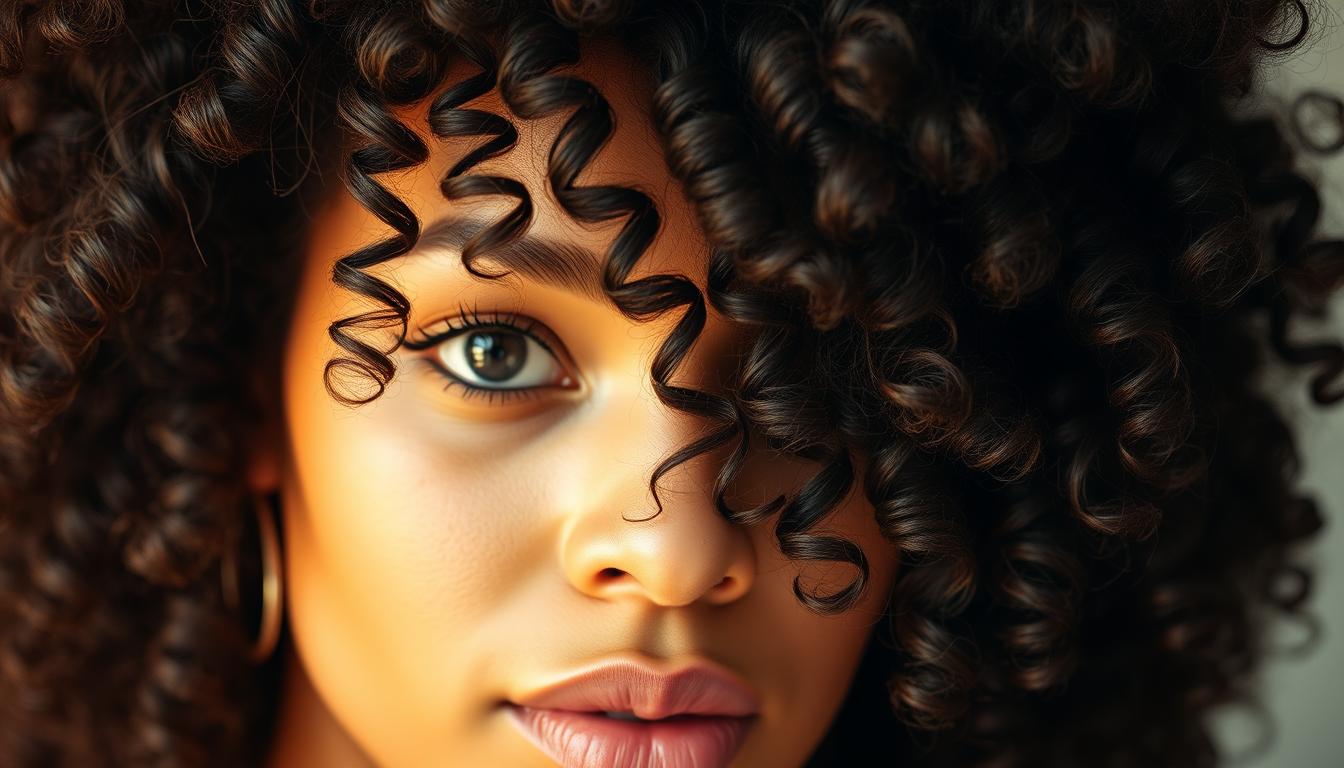
Curly hair is a beautiful and unique gift that deserves celebration. Whether you have loose waves or tight coils, natural curls offer incredible versatility and personality that sets you apart from the crowd. This comprehensive guide will help you unlock the full potential of your curly hairstyles, providing expert tips and techniques to showcase your stunning natural curls.
Understanding and embracing your curl pattern can transform your hair care routine. From selecting the right products to mastering styling techniques, we’ll explore everything you need to know about maintaining healthy, vibrant, and defined curls that turn heads wherever you go.
Curly hair is more than just a texture—it’s a statement of individuality and confidence. With the right knowledge and approach, you can transform your hair care routine and unleash the true potential of your natural curls.
Key Takeaways
- Discover the unique beauty of your natural curl pattern
- Learn essential techniques for curl care and styling
- Understand product selection for different curl types
- Embrace your curls with confidence and creativity
- Explore versatile curly hairstyles for every occasion
Understanding Your Natural Curl Pattern and Texture
Discovering the unique characteristics of your natural curls is the first step in achieving stunning, healthy wavy hair. Every curl pattern tells a story about your hair’s individual needs and potential. Curly hair care goes beyond simple styling – it’s about understanding the intricate curly hairstyles science behind your locks.
Identifying Your Curl Type: From Waves to Coils
Natural curls come in a diverse range of patterns, typically classified into four main categories:
- Type 2 (Wavy Hair): Loose, S-shaped waves with minimal definition
- Type 3 (Curly Hair): Defined circular patterns with more volume
- Type 4 (Coily Hair): Tight, springy curls with significant texture
The Science Behind Curly Hair Structure
The unique shape of hair follicles determines curl pattern. Oval or asymmetrical follicles create curly textures, while symmetrical follicles produce straight hair. Protein bonds and keratin structure play crucial roles in defining your natural curl’s shape and behavior.
| Curl Type | Follicle Shape | Characteristic |
|---|---|---|
| Wavy Hair | Slightly Oval | Soft S-shaped waves |
| Curly Hair | Oval | Defined circular patterns |
| Coily Hair | Asymmetrical | Tight, dense curls |
How Porosity Impacts Your Curl Care Routine
Hair porosity determines how well your natural curls absorb and retain moisture. Low porosity hair resists moisture, while high porosity hair absorbs it quickly. Understanding your hair’s porosity helps select the right products for optimal curly hair care.
- Low Porosity: Requires lightweight, penetrating products
- Medium Porosity: Responds well to balanced moisturizing treatments
- High Porosity: Needs heavy, protein-rich conditioning
Essential Products for Defining and Managing Curls
Mastering curl definition starts with selecting the right curly hair products. Every curl type requires a unique approach to hair care, making product selection crucial for achieving beautiful, healthy locks.
The foundation of exceptional curl care involves understanding your specific hair needs. Curl definition isn’t just about appearance – it’s about maintaining hair health and moisture balance.
- Cleansing Products:
- Sulfate-free shampoos
- Cream-based cleansers
- Co-washing solutions
- Conditioning Essentials:
- Hydrating leave-in conditioners
- Deep conditioning masks
- Protein-enriched treatments
- Styling Curl Definition Products:
- Curl-enhancing creams
- Defining gels
- Lightweight hair oils
Pro tip: Always choose curly hair products that match your specific curl pattern and porosity for optimal results.
“Great curls start with great products” – Curl Care Experts
When selecting curl definition products, consider ingredients like glycerin,curly hairstyles keratin, and natural oils that provide moisture and support curl structure. Avoid heavy silicones that can cause buildup and weigh down your beautiful curls.
The Art of Washing and Conditioning Curly Hair
Mastering curly hair care requires understanding the unique needs of your curl pattern. Proper washing and conditioning techniques are crucial for maintaining healthy, defined curls and controlling frizz.
Pre-Poo Treatments for Curl Preparation
Pre-poo treatments are essential for protecting curly hair during the washing process. curly hairstyles protective measures help:
- Minimize moisture loss
- Reduce potential damage
- Prepare hair for cleansing
Deep Conditioning for Maximum Moisture
Deep conditioning is a critical step in curly hair care. Intense hydration helps maintain curl integrity and prevents breakage.
| Conditioning Method | Benefits for Curly Hair |
|---|---|
| Overnight Treatment | Maximum moisture absorption |
| Steam Conditioning | Enhanced product penetration |
| Protein-Based Treatments | Strengthens hair structure |
Frizz Control Drying Techniques
Proper drying methods are crucial for frizz control. Techniques like plopping and micro-plopping help maintain curl definition while minimizing damage.
- Use a microfiber towel
- Avoid rubbing hair
- Apply leave-in conditioner
- Air dry or use low-heat diffuser
By implementing these curly hair care strategies, you can achieve beautiful,curly hairstyles well-defined curls with minimal frizz.
Popular Curly Hairstyles for Every Length
Styling curly hair can be an exciting journey of self-expression. Whether you have short, medium, or long locks, there are countless curly hairstyles to showcase your unique texture and personality.
For those with short curly hair, versatility is key. Pixie cuts and tight curls create a bold statement, while textured crops offer a playful and low-maintenance option. Professional stylists recommend embracing your natural curl pattern to maximize volume and definition.
- Pixie Curls: Edgy and dynamic style for short hair
- Textured Crop: Soft, manageable look for everyday wear
- Defined Ringlets: Tight, structured curls with maximum impact
Medium-length curly hairstyles provide incredible styling flexibility. Shoulder-length cuts allow for multiple styling options, from voluminous layers to sleek, controlled looks.
| Hair Length | Recommended Styles | Styling Difficulty |
|---|---|---|
| Short Curls | Pixie Cut, Textured Crop | Easy |
| Medium Curls | Layered Bob, Shoulder-Length Waves | Moderate |
| Long Curls | Romantic Ringlets, Bohemian Waves | Advanced |
Long curly hair opens up a world of stunning possibilities. Romantic ringlets,curly hairstyles bohemian waves, and intricate braided styles can transform your look from casual to glamorous in minutes. Curly hairstyles for long hair often require more maintenance but offer unparalleled beauty and drama.
Remember: The key to perfect curly hairstyles is understanding your unique curl pattern and embracing its natural texture.
Mastering Diffuser Techniques for Perfect Curl Definition
Curly-haired individuals know the struggle of achieving flawless curl definition. A hair diffuser becomes your secret weapon in transforming unruly locks into beautifully structured curls. Understanding diffuser techniques can dramatically improve your hair styling routine.
Diffusers work by spreading air flow evenly, reducing frizz and enhancing natural curl patterns. Proper use of these styling tools can make a significant difference in your hair’s appearance and health.
Heat Settings and Diffusing Methods
Selecting the right heat setting is crucial for curl definition. Low to medium heat prevents hair damage while maintaining curl integrity. Try these diffuser techniques:
- Pixie diffusing: Gently cup small sections of hair
- Hover diffusing: Keep diffuser slightly away from roots
- Scrunching method: Push curls upward toward the scalp
Root Volume Enhancement Strategies
Achieving volume starts at the roots. Flip your head upside down while diffusing to create lift and prevent flat, lifeless curls. Use a circular motion to encourage natural curl formation.
Drying Time and Motion Techniques
Patience is key when using diffuser techniques. Dry your hair until it’s about 80% complete, then allow natural air drying. Gentle, consistent motion prevents disrupting curl patterns and reduces frizz.
Pro tip: Always use a heat protectant before diffusing to maintain curl health and definition.
Protective Styling Methods for Curly Hair Growth

Curly hair care requires special attention, especially when promoting healthy hair growth.curly hairstyles Protective styling stands out as a crucial strategy for maintaining the health and length of curly hair textures.
Protective hairstyles create a shield for delicate curl patterns, minimizing breakage and reducing daily manipulation. These styles work by tucking away vulnerable hair ends and preventing environmental damage.
- Braided styles that protect hair roots
- Twist-outs with minimum manipulation
- Buns and updos that reduce friction
- Cornrows for maximum hair protection
Key considerations for successful protective curly hairstyles include:
- Maintain moisture before styling
- Use silk or satin scrunchies
- Limit styling time to 2-4 weeks
- Always prepare hair with deep conditioning
“Protective styling isn’t just about looks—it’s about nurturing your natural curl pattern.” – Professional Curl Specialist
When implementing protective styles for curly hair care,curly hairstyles gentle installation and careful removal are critical. Avoid tight styles that create tension and potentially damage your delicate curl structure.
Proper scalp care remains essential during protective styling. Regular moisturizing and occasional cleansing will keep your scalp healthy and support continuous hair growth.
Combating Frizz: Tips and Solutions
Frizz control is a critical aspect of curly hair care that can transform your hair’s appearance and health. Understanding the root causes of frizz helps create an effective strategy to manage unruly curls and maintain smooth, defined locks.
Curly hair is naturally prone to frizz due to its unique structure and moisture sensitivity.curly hairstyles The key to successful frizz management lies in a comprehensive approach that addresses multiple factors.
Humidity Defense Strategies
Protecting your curls from humidity requires a multi-step approach:
- Use anti-humidity hair products with silicone or polymer barriers
- Apply leave-in conditioners that seal the hair cuticle
- Choose styling creams with humidity-resistant properties
Product Layering Methods
Effective product layering is crucial for frizz control. Create a protective shield for your curls by following this recommended sequence:
- Start with a lightweight leave-in conditioner
- Apply a curl-defining cream
- Seal with an anti-humidity gel or serum
Nighttime Protection Routines
Preserve your curl definition and minimize frizz while you sleep with these techniques:
| Protection Method | Benefit |
|---|---|
| Satin Pillowcase | Reduces friction and prevents moisture loss |
| Silk Bonnet | Protects curl structure and prevents tangling |
| Pineapple Hair Technique | Maintains volume and prevents crushing curls |
Consistent curly hair care practices are the ultimate defense against persistent frizz.
Seasonal Care Tips for Curly Hair
Curly hair care requires special attention throughout the year.curly hairstyleshttps://lifebridg.com/makeup/ Natural curls demand unique strategies to combat changing environmental conditions. Each season brings distinct challenges that can impact the health and appearance of your beautiful texture.
Summer humidity can wreak havoc on curly hair, causing unwanted frizz and volume. To protect your natural curls during hot months, consider these essential tips:
- Use lightweight, anti-humidity styling products
- Opt for protective hairstyles like braids or updos
- Apply leave-in conditioners with UV protection
- Minimize heat styling to prevent additional damage
Winter presents opposite challenges with dry, cold air that can strip moisture from curly hair. Implement a winter curly hair care routine that focuses on intense hydration:
- Deep condition weekly with rich, moisturizing treatments
- Use silk or satin-lined bonnets and pillowcases
- Reduce wash frequency to prevent additional dryness
- Layer styling products for maximum moisture retention
Pro tip: Always adjust your hair care routine based on your specific curl type and local climate conditions.
Transitional seasons like spring and fall require a balanced approach to curly hair care. Pay attention to your hair’s changing needs and be prepared to modify your styling and conditioning techniques accordingly.
Natural Remedies and DIY Treatments for Healthy Curls
Curly hair care goes beyond store-bought products. Natural remedies can transform your natural curls, providing nourishment and shine without harsh chemicals.curly hairstyles Homemade treatments offer a personalized approach to hair health that can be both effective and budget-friendly.
Creating DIY masks and treatments allows you to understand your hair’s unique needs. Let’s explore some powerful natural ingredients that can revolutionize your curly hair care routine:
- Coconut oil for deep moisture
- Avocado for protein and nutrients
- Honey for natural hydration
- Aloe vera for scalp health
Here’s a quick guide to a nourishing hair mask for natural curls:
| Ingredient | Quantity | Benefit |
|---|---|---|
| Ripe Avocado | 1 whole | Protein and moisture |
| Honey | 2 tablespoons | Natural humectant |
| Coconut Oil | 1 tablespoon | Deep conditioning |
Always patch test new ingredients to prevent potential allergic reactions.curly hairstyles Remember that everyone’s curly hair is unique, so what works for one person might not work exactly the same for another.
Natural ingredients can be powerful allies in your curly hair care journey.
Experiment with these DIY treatments, listen to your hair’s needs, and enjoy the process of nurturing your beautiful natural curls.
Conclusion
Navigating the world of curly hairstyles is more than just a beauty routine—it’s a celebration of individuality. Your natural curls tell a unique story, reflecting personal identity and natural beauty. Understanding your specific curl pattern empowers you to unlock incredible styling potential and hair health.
The path to incredible curly hair begins with knowledge and care. Learning about moisture techniques, protective styling, and specialized product selection transforms your hair care approach. Professional stylists and curl experts now recognize that natural curls deserve specialized attention, moving beyond traditional hair care narratives.
Curl confidence comes from understanding and nurturing your unique texture. Whether you have waves, tight coils, or loose ringlets, each curl pattern represents beautiful diversity.curly hairstyles The beauty industry’s growing embrace of natural curls signals a powerful shift toward authentic self-expression and hair acceptance.
Your curly hair journey is ongoing—filled with discovery, experimentation,curly hairstyles and self-love. By investing time in proper techniques and maintaining healthy practices, you’ll reveal the stunning potential of your natural curls. Remember, every curl is beautiful, and your hair is a magnificent expression of who you are.
FAQ
How do I determine my natural curl type?
To identify your curl type, examine your hair’s pattern when it’s wet and product-free. Curl patterns range from wavy (Type 2) to curly (Type 3) to coily (Type 4). Look for the shape of your natural curl – loose S-waves, defined ringlets, or tight zigzag patterns. Each type requires different care and styling techniques to enhance natural curl definition.
What are the best products for controlling frizz in curly hair?
Look for anti-humidity products containing ingredients like silicone, argan oil,curly hairstyles or shea butter. Leave-in conditioners, curl creams, and lightweight gels can help control frizz. Brands like DevaCurl, Ouidad, and Cantu offer specialized frizz-control products designed specifically for curly and wavy hair textures.
How often should I wash my curly hair?
Curly hairhttps://www.pinterest.com/pin/983403268647467224/ tends to be drier and more prone to damage, so limit washing to 1-3 times per week. Use sulfate-free shampoos and focus on co-washing (conditioning wash) between full shampoo sessions.curly hairstyles The frequency depends on your specific curl type, scalp condition, and lifestyle activities.
What is the best way to dry curly hair to prevent frizz?
Use a microfiber towel or soft t-shirt to gently squeeze out excess water, avoiding rubbing which causes frizz. Try the plopping technique, where you wrap wet hair in a microfiber towel or cotton t-shirt to help define curls. A diffuser attachment on low heat can also help dry curls while maintaining their natural shape.
How can I protect my curls while sleeping?
Use a satin or silk pillowcase to reduce friction and prevent frizz. Alternatively, wrap your hair in a satin bonnet or use the pineapple method – loosely gathering hair at the top of your head in a high, loose ponytail. This helps preserve curl definition and prevents tangles overnight.
Are heat styling tools safe for curly hair?
Minimal heat styling is recommended. When using heat, always apply a heat protectant first and use the lowest temperature setting possible. Limit heat styling to occasional use,curly hairstyles and opt for heatless styling methods like twist-outs, braid-outs, or air-drying to maintain curl health.
How can I add moisture to my dry, curly hair?
Deep conditioning treatments are crucial for curly hair. Use leave-in conditioners,curly hairstyles hair masks, and natural oils like coconut or argan oil. The LOC (Liquid-Oil-Cream) method works well for adding and sealing in moisture. Look for products with hydrating ingredients like glycerin, aloe vera, and botanical extracts.
What are the best protective styles for curly hair?
Protective styles include braids, twists, buns, and updos that tuck away the hair ends and minimize manipulation. Bantu knots, two-strand twists, and crochet braids are excellent options that protect hair while maintaining curl pattern. Ensure styles are not too tight to prevent stress on the hair and scalp.






